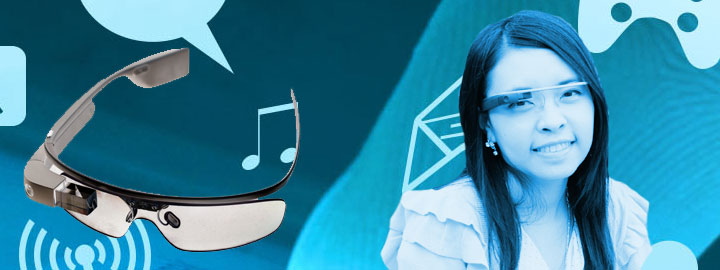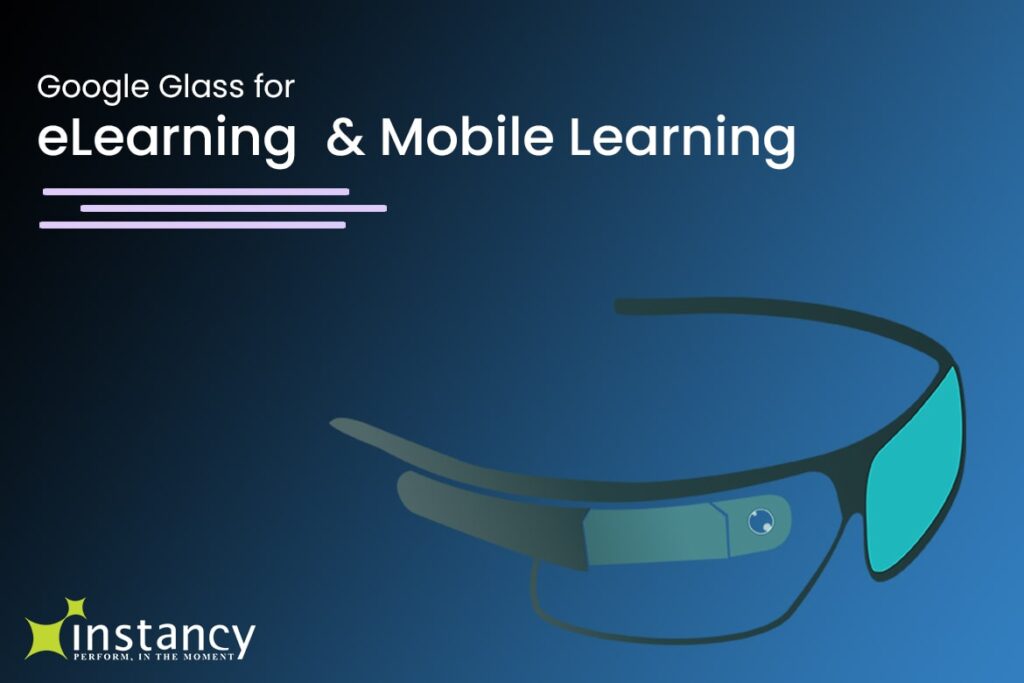These Days Google Glass as Become an Important Device in eLearning and Mobile Learning Platforms. Where Users Experience the Most Advanced way of Online Learning.

Google Glass is a “wearable” computer device with an optical head-mounted display (OHMD).
Google Glass displays information in a smartphone-like hands-free format. Google Glass can connect with your Smartphone via Bluetooth connection and leverage information and apps on your Smartphone.
What can Google Glass do?
Google Glass provides Google’s cloud features like maps, Gmail, calendar, Google+ and Google Places. Google Glass offers language voice command support, Bluetooth and Wi-Fi connectivity and allows a user to take photos and videos.
Google Glass responds to voice commands, leaving a user’s hands free. It follows the wearer’s gaze, enabling a learner to concentrate on the task. Google Glass can share and search for content, detect objects in front, and look up directions or maps etc. With a wide range of useful features, Google Glass has the potential to change the way we learn and train knowledge workers or students in academic settings.
Google Glass in Learning
Wearable technology like Google Glass takes mobile technology to a whole new level and online learning can leverage this technology to improve instruction, learning and application of learning.
Google glass can be used for:
- Managing class and study schedules, reminders and alerts
- Pushing certain key concepts or providing flash card functionality to aid in the learning process
- Using voice commands, learners can look up information, prior learning, knowledge-base and so on from any location – in the class, outside the class, museum, field trip, etc.
- Video conferencing and virtual coaching
- Audio/Video capturing and taking notes on the fly
- Presenting lectures/content
A more unique learning application of Google Glass is Augmented Reality. Augmented Reality (AR) is a live view of a real-world environment captured through in-built camera. AR enhances the live view by simultaneously presenting computer-generated input like text, sound, video, graphics, etc. on the screen. With AR technology, information about the surrounding world becomes interactive and digitally changeable and it can help the user learn, explore and interact with information about the real-world environment.
In the Classroom
Google Glass can help a learners stay connected to the learning environment totally hands free. Learners can refer to relevant learning material on the go. A learner can also use Google Glass to record classroom training sessions in real-time. Interactions with fellow learners can be recorded while on field trips and while out of the classroom in general. Google Glass can help in creating engaging projects and presentations. Google Translator can present text-based translation in real-time.
In K-12 or higher education, Google Glass can help compare live feeds with an assignment or research paper. Small sized videos can enhance the learning experience dramatically for a learner who may otherwise find the subject drab or uninteresting.
AR games in the classroom can add a new dimension to learning with interactivity. Learners can explore a human body and isolate various body systems. It is possible to add video profiles, sport highlights, skits and concert footage with this technology. In fact, AR has endless possibilities, allowing learners to unleash their creativity and construct their own world.
For an Instructor
For a presenter or instructor, Google Glass can be used for presenting webinars and video-based tutorials. These can be streamed directly onto a learner’s Glass to be accessed on the go. Teachers have a chance to see the classroom through learners’ eyes with this gadget. A screen with an Internet connection is handy while teaching in the classroom or outdoors.
Case Studies
Google Glass was used in education by creating a well-known projects such as STEMbite (http://www.youtube.com/STEMbite/). A YouTube channel with a series of bite-size videos demonstrated the math and science of daily life. This has been a totally new teaching and learning experience for learners. (Buchem & Pérez-Sanagustín, 2013).
Google Glass has proved to be a useful educational tool for medical apprentices. Vallurupalli et al used Google Glass (Glauser, 2013) for various scenarios in cardiovascular practice and a mock trainee used Google glass to enact each scenario. Live video stream from Google Glass was transmitted to smartphones of other learners in the group. It enhanced education and patient outcomes in the cardiology fellowship program and also showed a patient’s perspective to the learner.
Another renowned mission is Margaret Powers’ “365 Days of Glass Project” . Margaret documents how she and the learners are using Glass in the school. Recently, kindergarten learners were recorded as they made flowers out of cups, cardboard, and other materials. The first-person perspective on her website is a great learning for other teachers who can replicate the lesson in their own classroom. (http://blog.kathyschrock.net/2014/02/google-glass-in-class.html)
Advantages and Limitations
Google Glass shows great promise in many spheres of learning and training and it has generated great excitement for learners and instructors. Virtual field trips, real time broadcasting, videos and many other smart options make it a boon for learners and teachers. However, there are privacy issues associated with using it in classrooms. The distraction factor with Google Glass is another drawback. Memorization will no longer be important as information will be readily available for reference at all times.
Summary
Wearable computers, mobile apps, sensor-enabled devices, and wireless connectivity are transforming the way people work and learn. Already in the hands of developers like Instancy, Google Glass is an upcoming mobile technology that promises to opens up a range of possibilities for the learners and instructors at school and the workplace. Google Glass can be the future of learning as it is compatible with new trends like just-in-time learning, personalization, and augmented reality.




